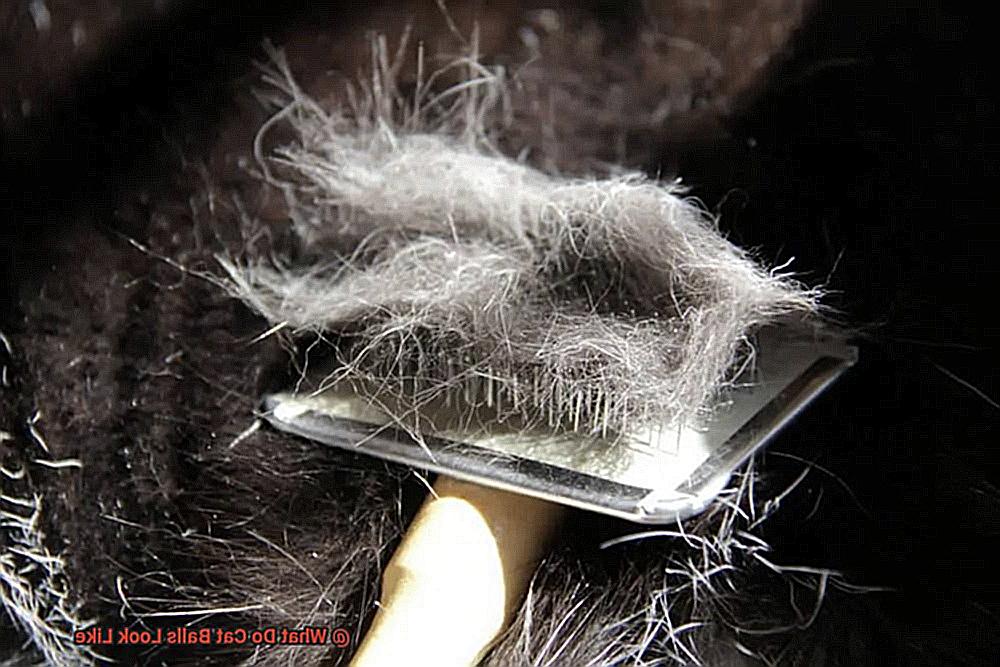As a cat parent, have you ever wondered what those little balls inside your kitty’s paw pads look like?
These tiny, circular pads are also called “digital pads,” and they play an essential role in your kitty’s stability and mobility. Not only do these small pads give your feline friend stability, but they also act as shock absorbers as they walk and hop around.
So, what exactly do cat balls look like? Well, they resemble little bubbles or raised discs on the bottom of each paw’s foot.
These toughened pads ensure adequate support and prevent any injuries that may arise due to rough terrain. Additionally, these pads have touch-sensitive nerves that help your kitty know what type of floor they’re walking on – be it carpet, tiles, or wood.
The number of cat balls that your furry pal has depends on their age and weight. Younger kittens have fewer paw pads than adult cats, and their pads usually develop as they mature.
Similarly, heavier cats have more digital pads than their lighter counterparts to distribute their weight evenly across each paw. In conclusion, cat balls are crucial for your feline’s mobility as they provide cushioning, stability, and help regulate body weight.
So, next time you cuddle with your furry friend, take a moment to appreciate their cute little paw pads and all that they do for them.

What are Cat Balls?
Cat balls are not just a vital part of a male cat’s anatomy, but they are also an essential component of your feline friend’s playtime.
These toys come in different shapes, sizes, and textures, but their goal is the same: to keep your cat active, engaged and to stimulate their natural hunting instincts. Ping pong balls, crinkle balls, soft fabric balls, and plastic balls with bells or feathers attached are some of the most common types of cat balls.
These toys are designed to be lightweight and easy to bat around, making them perfect for your furry friend to swat and chase. Playing with cat balls provides numerous health benefits for your cat.
Firstly, it promotes physical fitness, which is essential for maintaining good health and avoiding obesity. Secondly, it promotes mental stimulation, which is crucial to cats’ overall wellbeing.
Lastly, some cat balls are made from materials safe for cats to chew on, such as rubber or silicone. These toys can help keep your feline’s teeth clean and shiny by removing plaque and tartar.
It’s important to remember that while playing with cat balls can provide hours of entertainment for your furry friend, they should always be supervised while playing. This is especially true if your cat likes to chew or swallow small objects, as this can pose a choking hazard.
Additionally, rotating your cat’s toys regularly keeps them interested and engaged in playtime. In conclusion, cat balls are an essential part of your feline friend’s playtime routine.
These toys provide countless hours of fun and entertainment while promoting physical fitness and mental stimulation. By keeping your cat active and engaged with these toys, you’re helping them live a happy and healthy life.
Anatomy of Cat Balls
Firstly, it’s important to understand that these furry little balls are more than just playthings for your feline friend. They are, in fact, essential reproductive organs that produce sperm and testosterone.
The testicles are located in the scrotum, a sac-like structure situated between the cat’s hind legs. This area is covered in fur and has a wrinkled appearance.
While the size of cat balls varies based on factors such as age, breed, and size, they are typically around the size of a grape or small cherry. However, during mating season, these balls can enlarge significantly due to increased blood flow.
Think of it as their own version of a pumped-up muscle. It’s worth noting that not all male cats will have visible testicles.
In some cases, a condition called cryptorchidism can occur where one or both testicles fail to descend into the scrotum. This condition can lead to health problems and should be addressed by a veterinarian.
It’s crucial to understand the anatomy of cat balls to ensure our pets’ health and wellbeing. By knowing what to look for and when to seek veterinary care, we can help our cats live happy and healthy lives.
But let’s not forget the fun side of cat balls. These toys play an important role in physical fitness, mental stimulation, and even dental hygiene for our feline friends.
From ping pong balls to crinkle balls, there are endless options to keep our cats entertained and healthy. In conclusion, understanding the anatomy of cat balls is essential knowledge for all cat owners.
Size and Variation of Cat Balls

Cat balls come in various shapes and sizes, ranging from a tiny cherry to a grape.
Generally, male cats have larger balls than female cats. However, it’s important to note that the size can vary depending on the breed, age, and health of the cat.
When it comes to examining your cat’s balls, you must look for smooth, firm, and symmetrical balls. They shouldn’t be too hard or too soft to touch.
Any lump or bump on the surface could indicate an underlying health condition. Hence, regular examination and observation of your cat’s balls are essential to detect any abnormalities early.
Besides size and texture, the color of cat balls can also vary based on the breed and age of the cat. For instance, kittens usually have pink or light-colored balls, while adult cats have more vibrant ones.
Some breeds like Siamese and Himalayan cats may even have blue or lavender-colored balls. It’s not just about examining their balls for abnormalities; these tiny organs also provide physical fitness, mental stimulation, and dental hygiene for our feline friends.
So, don’t be afraid to give those little balls a good once-over-time every now and then – your cat will thank you for it. In conclusion, understanding the size and variation of cat balls is crucial for pet owners.
The Spermatic Cord and Its Role
Think of the spermatic cord as the ultimate highway system, linking the testicles to the abdominal cavity. But it’s not just any old roadway.
No, this cord is responsible for ensuring that sperm reaches its final destination during ejaculation safely and speedily. But wait, there’s more.
The spermatic cord also acts as a lifeline for the testicles, providing them with essential nutrients and oxygen while removing metabolic waste products. It’s like a food delivery service and garbage disposal rolled into one.
And during ejaculation, the spermatic cord also plays a vital role in regulating the contraction of the testicles. It’s like a traffic controller, directing the flow of traffic to avoid any crashes or hold-ups.
But that’s not all. The spermatic cord is also covered by layers of tissue, including the cremaster muscle, which acts as a temperature regulator for the testicles.
This muscle ensures that the temperature stays just right for optimal sperm production.
Importance of Knowing Your Cat’s Normal Anatomy
By understanding your furry friend’s anatomy, you can detect any changes or abnormalities early on and seek prompt veterinary care, ensuring your cat’s overall health and well-being.
One of the most distinctive features of male cats is their testicles, affectionately known as “cat balls.” These are located in the scrotum, a sac-like structure found beneath the anus.
However, it’s important to note that the size and appearance of these testicles can vary based on factors such as age, breed, and health status. If your male cat has been neutered, you won’t be able to see their testicles.
Neutering is a common surgical procedure that removes the testes to prevent unwanted breeding and reduce certain health risks. Female cats, on the other hand, have two small openings near their anus that lead to their reproductive organs.
These are not visible like male testicles but are just as important to monitor. Regularly checking your cat’s reproductive organs can help you detect any unusual discharge or changes in size, shape, or texture.
In addition to monitoring your cat’s anatomy at home, regular check-ups with your veterinarian are essential for maintaining their health.
Signs of Abnormalities in the Scrotal Area

Any abnormalities in this region may indicate a variety of health issues that require immediate attention from a veterinarian.
Swelling
One of the most common signs of abnormalities in the scrotal area is swelling. If you notice that your cat’s scrotum is larger than usual, it could indicate fluid accumulation, which can occur due to trauma or infection.
In some cases, swelling can also be caused by testicular tumors, which can be cancerous or non-cancerous. So, just like you would monitor your own body for any unusual swellings, you need to do the same for your feline friend.
Redness or Irritation
Another sign of abnormalities in the scrotal area is redness or irritation. If your cat’s scrotum appears red or inflamed, it could be a sign of infection.
Feline infectious peritonitis (FIP) and feline immunodeficiency virus (FIV) are two common infections that can cause scrotal inflammation. It’s like when you have a rash or infection on your skin – except for your cat, it’s happening in their “private parts.”
Testicular Atrophy
If your cat’s testicles appear smaller than usual or are hard to the touch, it may be a sign of testicular atrophy. This condition occurs when the testicles shrink due to injury, infection, or hormonal imbalances.
Testicular atrophy can also be a side effect of neutering. It’s like when your muscles haven’t been used for a long time – except for cats, where it’s happening in their testicles.
Lastly, if you notice any discharge or blood in the scrotal area, it’s essential to seek veterinary attention immediately. Discharge or blood can indicate infections, tumors, or other serious health issues that require prompt treatment.
It’s similar to when blood or pus comes from a wound – but for cats, it’s happening in their scrotal area. In conclusion, monitoring your cat’s scrotal area for any abnormalities is crucial for maintaining their health and well-being.
bJS7sbKxy_Q” >
Conclusion
In conclusion, understanding the significance of cat balls is a crucial aspect of being a responsible cat owner.
These tiny, circular pads on their paws are not just cute; they also provide stability, cushioning, and aid in controlling body weight. Meanwhile, cat balls are essential reproductive organs that produce sperm and testosterone.
But wait, there’s more. Cat balls also play a vital role in their playtime routine by promoting physical fitness, mental stimulation, and dental hygiene.
So it’s not just about reproduction; it’s about overall well-being. Regular examination of your cat’s reproductive organs is highly recommended to detect any abnormalities early on and seek prompt veterinary attention.
Keep an eye out for swelling, redness, or irritation in the scrotal region; smaller than average testicles or hard-to-the-touch testicles; discharge or blood. These signs could indicate fluid accumulation due to injury or viral imbalances, tumors or other significant health conditions.
To ensure that your furry friends live happy and healthy lives, monitor their health and well-being through regular visits with your veterinarian and tracking their behavior at home.







